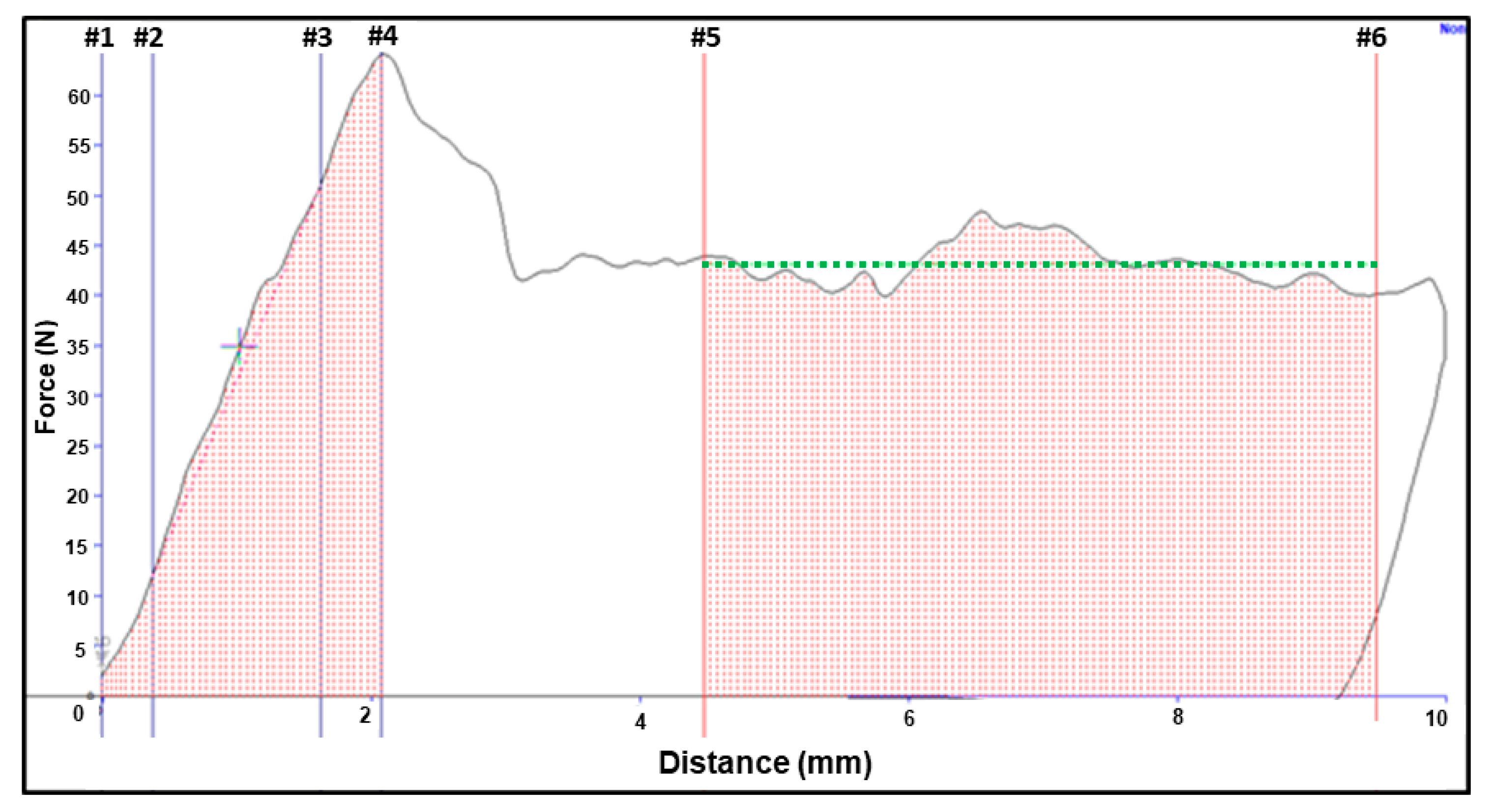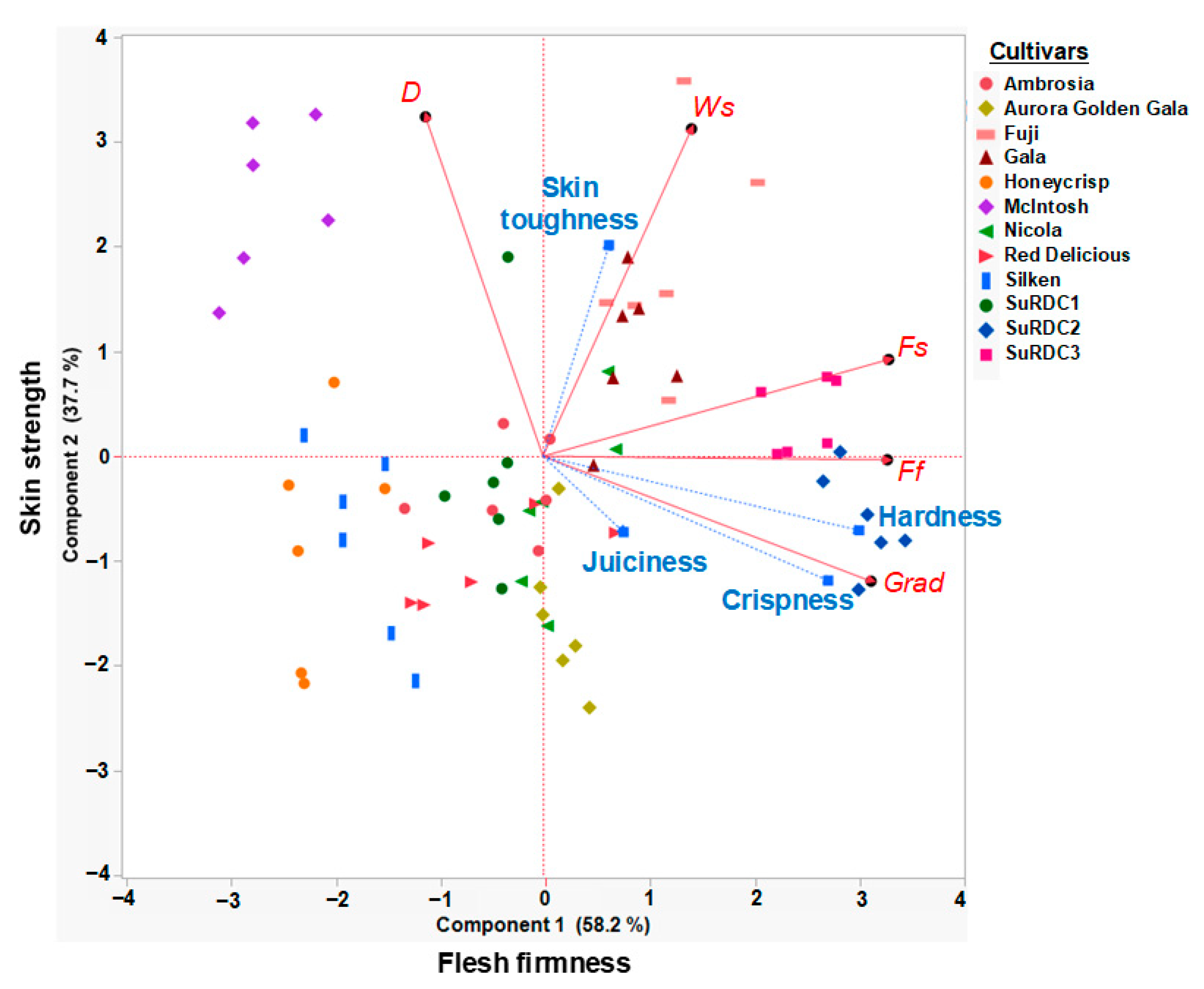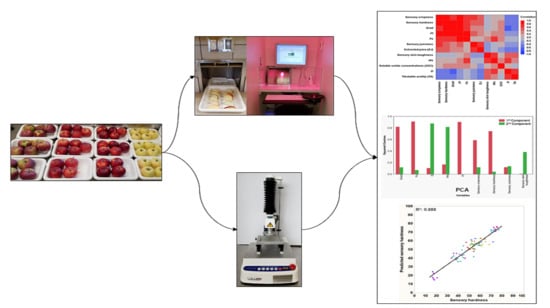Modelling and Classification of Apple Textural Attributes Using Sensory, Instrumental and Compositional Analyses
Abstract
1. Introduction
2. Materials and Methods
2.1. Apple Cultivars
2.2. Sensory Assessment
2.3. Instrumental Firmness Measurements
2.4. Basic Compositional Measurements
2.5. Statistical Analysis
3. Results and Discussion
3.1. Comparisons of the Results of Two Experiments
3.2. Bivariate Pearson Correlation Coefficients
3.3. Principal Component Analysis Using TA.XTplus Measurements and Supplementary Sensory Textural Variables
3.4. Evaluating the Accuracy of Apply Textural Classifications Using TA.XTplus Measurements
3.5. Predictive Sensory Models
4. Conclusions
Supplementary Materials
Author Contributions
Funding
Institutional Review Board Statement
Informed Consent Statement
Data Availability Statement
Acknowledgments
Conflicts of Interest
References
- Kilcast, D.; Fillion, L. Understanding consumer requirements for fruit and vegetable texture. Nutr. Food Sci. 2001, 31, 221–225. [Google Scholar] [CrossRef]
- Almli, V.L. What Influences Apple Consumers’ Preferences? A Perspective on Intrinsic and Extrinsic Factors. In Proceedings of the Oral Session Presentation at the Meeting of Interpoma, Bolzano, Italy, 24–26 November 2016. [Google Scholar]
- Bejaei, M.; Cliff, M.A.; Singh, A. Multiple correspondence and hierarchical cluster analyses for the profiling of fresh apple customers using data from two marketplaces. Foods 2020, 9, 873. [Google Scholar] [CrossRef] [PubMed]
- Oraguzie, N.; Alspach, P.; Volz, R.; Whitworth, C.; Ranatunga, C.; Weskett, R.; Harker, R. Postharvest assessment of fruit quality parameters in apple using both instruments and an expert panel. Postharvest Biol. Technol. 2009, 52, 279–287. [Google Scholar] [CrossRef]
- Cliff, M.A.; Stanich, K.; Lu, R.; Hampson, C.R. Use of descriptive analysis and preference mapping for early-stage assessment of new and established apples. J. Sci. Food Agric. 2016, 96, 2170–2183. [Google Scholar] [CrossRef]
- Charles, M.; Corollaro, M.L.; Manfrini, L.; Endrizzi, I.; Aprea, E.; Zanella, A.; Grappadelli, L.C.; Gasperi, F. Application of a sensory–instrumental tool to study apple texture characteristics shaped by altitude and time of harvest. J. Sci. Food Agric. 2018, 98, 1095–1104. [Google Scholar] [CrossRef]
- Abbott, J.A.; Massie, D.R.; Upchurch, B.L.; Hruschka, W.R. Nondestructive sonic firmness measurement of apples. T. ASABE 1995, 38, 1461–1466. [Google Scholar] [CrossRef]
- Harker, F.R.; Maindonald, J.; Murray, S.H.; Gunson, F.A.; Hallett, I.C.; Walker, S.B. Sensory interpretation of instrumental measurements 1: Texture of apple fruit. Postharvest Biol. Technol. 2002, 24, 225–239. [Google Scholar] [CrossRef]
- Mehinagic, E.; Royer, G.; Bertrand, D.; Symoneaux, R.; Laurens, F.; Jourjon, F. Relationship between sensory analysis, penetrometry and visible–NIR spectroscopy of apples belonging to different cultivars. Food Qual. Prefer. 2003, 14, 473–484. [Google Scholar] [CrossRef]
- Li, G.; Zhao, G.; Wang, X.; Liu, X. Nondestructive measurement and fingerprint analysis of apple texture quality base on NIR spectra. Trans. Chin. Soc. Agric. Eng. 2008, 24, 169–173. [Google Scholar] [CrossRef]
- Corollaro, M.L.; Aprea, E.; Endrizzi, I.; Betta, E.; Demattè, M.L.; Charles, M.; Bergamaschi, M.; Costa, F.; Biasioli, F.; Grappadelli, L.C.; et al. A combined sensory-instrumental tool for apple quality evaluation. Postharvest Biol. Technol. 2014, 96, 135–144. [Google Scholar] [CrossRef]
- Cliff, M.A.; Bejaei, M. Inter-correlation of apple firmness determinations and development of cross-validated regression models for prediction of sensory attributes from instrumental and compositional analyses. Food Res. Int. 2018, 106, 752–762. [Google Scholar] [CrossRef]
- Chang, H.-Y.; Vickers, Z.M.; Tong, C.B.S. The use of a combination of instrumental methods to assess change in sensory crispness during storage of a “Honeycrisp” apple breeding family. J. Texture Stud. 2018, 49, 228–239. [Google Scholar] [CrossRef]
- Harker, F.R.; Feng, J.; Johnston, J.W.; Gamble, J.; Alavi, M.; Hall, M.; Chheang, S.L. Influence of postharvest water loss on apple quality: The use of a sensory panel to verify destructive and non-destructive instrumental measurements of texture. Postharvest Biol. Technol. 2019, 148, 32–37. [Google Scholar] [CrossRef]
- Johnston, J.W.; Hewett, E.W.; Banks, N.H.; Harker, F.R.; Marteen Hertog, L.A.T.M. Physical change in apple texture with fruit temperature: Effect of cultivar and time in storage. Postharvest Biol. Technol. 2001, 23, 13–21. [Google Scholar] [CrossRef]
- Teh, S.L.; Brutcher, L.; Schonberg, B.; Evans, K. Eleven-year correlation of physical fruit texture traits between computerized penetrometers and sensory assessment in an apple breeding program. Horttechnology 2020, 30, 719–724. [Google Scholar] [CrossRef]
- Camps, C.; Guillermin, P.; Mauget, J.C.; Bertrand, D. Data analysis of penetrometric force/displacement curves for the characterization of whole apple fruits. J. Texture Stud. 2005, 36, 387–401. [Google Scholar] [CrossRef]
- Grotte, M.; Duprat, F.; Loonis, D.; Piétri, E. Mechanical properties of the skin and the flesh of apples. Int. J. Food Prop. 2001, 4, 149–161. [Google Scholar] [CrossRef]
- Costa, F. Mechanical investigation to assess the peel contribution in apple fruit. Postharvest Biol. Technol. 2016, 111, 41–47. [Google Scholar] [CrossRef]
- Costa, F.; Cappellin, L.; Longhi, S.; Guerra, W.; Magnago, P.; Porro, D.; Soukoulis, C.; Salvi, S.; Velasco, R.; Biasioli, F.; et al. Assessment of apple (Malus × domestica Borkh.) fruit texture by a combined acoustic-mechanical profiling strategy. Postharvest Biol. Technol. 2011, 61, 21–28. [Google Scholar] [CrossRef]
- Mehinagic, E.; Royer, G.; Symoneaux, R.; Bertrand, D.; Jourjon, F. Prediction of the sensory quality of apples by physical measurements. Postharvest Biol. Technol. 2004, 34, 257–269. [Google Scholar] [CrossRef]
- Mehinagic, E.; Madieta, E.; Symoneaux, R.; Jourjon, F. How to measure objectively apple juiciness? Rev. Suisse Vitic. Arboric. Hortic. 2009, 41, 127–131. [Google Scholar]
- Bárcenas, P.; Pérez Elortondo, F.J.; Albisu, M. Sensory comparison of several cheese varieties manufactured from different milk sources. J. Sens. Stud. 2005, 20, 62–74. [Google Scholar] [CrossRef]
- Ballabio, D.; Consonni, V.; Costa, F. Relationships between apple texture and rheological parameters by means of multivariate analysis. Chemom. Intell. Lab. Syst. 2012, 111, 28–33. [Google Scholar] [CrossRef]
- Iwanami, H.; Moriya, S.; Okada, K.; Abe, K.; Kawamorita, M.; Sasaki, M.; Moriya-Tanaka, Y.; Honda, C.; Hanada, T.; Wada, M. Instrumental measurements of juiciness and freshness to sell apples with a premium value. Sci. Hortic. 2017, 214, 66–75. [Google Scholar] [CrossRef]
- Barreiro, P.; Ortiz, C.; Ruiz-Altisent, M.; De Smedt, V.; Schotte, S.; Andani, Z.; Wakeling, I.; Beyts, P.K. Comparison between sensory and instrumental measurements for mealiness assessment in apples. A collaborative test. J. Texture Stud. 1998, 29, 509–525. [Google Scholar] [CrossRef]
- Joardder, M.U.; Brown, R.J.; Kumar, C.; Karim, M.A. Effect of cell wall properties on porosity and shrinkage of dried apple. Int. J. Food Prop. 2015, 18, 2327–2337. [Google Scholar] [CrossRef]
- Palmer, J.W.; Harker, F.R.; Tustin, D.S.; Johnston, J. Fruit dry matter concentration: A new quality metric for apples. J. Sci. Food Agric. 2010, 90, 2586–2594. [Google Scholar] [CrossRef]



| Parameter Abbreviation | Units of Measure | Description of Parameter | Method of Calculation and Location on Force-Distance Curve |
|---|---|---|---|
| Fs | Newton (N) | The maximum force (recorded on y-axis) required to rupture apple skin and flesh | Shown by anchor #4 on Figure 1 |
| Ws | Nmm | Mechanical work conducted to rupture skin and flesh | Calculated from the triangle area under the curve between anchors #1 and #4 on Figure 1 |
| Grad | N/mm | The gradient on the force-distance curve between 20% and 80% a of Fs to measure the slope of the firmness | Calculated from the slope between anchors #2 and #3 on Figure 1 |
| D | mm | The probe position (on x-axis) at Fs | Measured from the distance between anchors #1 and #4 on the x-axis of Figure 1 |
| Ff | N | The average force required to puncture the flesh between 4.5 mm and 9.5 mm a | Calculated by the average of force recorded between anchor #5 to #6 on Figure 1 |
| Wf | Nmm | Work to rupture the flesh between 4.5 and 9.5 mm b | Calculated from the marked rectangle area under the curve between anchors #5 and #6 on Figure 1 |
| Experiment 1 | Experiment 2 | ||||||||||
|---|---|---|---|---|---|---|---|---|---|---|---|
| Mean | SE | Min. | Max. | Mean | SE | Min. | Max. | t-Test | Significance (2-Tailed) | ||
| Sensory a | Crispness | 59.48 | 1.78 | 31.50 | 74.58 | 61.31 | 1.78 | 28.63 | 74.50 | 0.72 | 0.47 |
| Hardness | 51.17 | 2.55 | 16.68 | 75.23 | 52.64 | 2.55 | 16.64 | 76.82 | 0.41 | 0.69 | |
| Juiciness | 58.32 | 0.87 | 49.00 | 66.38 | 59.74 | 0.87 | 47.05 | 68.71 | 1.16 | 0.25 | |
| Skin toughness | 51.96 | 1.33 | 34.59 | 66.68 | 52.6 | 1.33 | 38.41 | 66.59 | 0.34 | 0.73 | |
| Instrumental b | Fs | 65.22 | 1.85 | 48.45 | 88.20 | 65.93 | 1.85 | 45.84 | 86.78 | 0.27 | 0.79 |
| Ws | 87.02 | 3.24 | 56.42 | 116.02 | 89.86 | 3.24 | 50.04 | 143.39 | 0.62 | 0.54 | |
| Grad | 27.85 | 0.99 | 16.19 | 42.35 | 27.56 | 0.99 | 16.90 | 40.30 | −0.21 | 0.84 | |
| D | 2.66 | 0.06 | 2.00 | 3.73 | 2.69 | 0.06 | 2.22 | 3.58 | 0.27 | 0.79 | |
| Ff | 39.23 | 1.28 | 24.83 | 56.24 | 39.97 | 1.28 | 25.12 | 55.29 | 0.41 | 0.68 | |
| Compositional c | Expressed juiciness (EJ) | 1.83 | 0.04 | 1.16 | 2.23 | 1.83 | 0.04 | 1.13 | 2.28 | 0.02 | 0.98 |
| Titratable acidity (TA) | 4.38 | 0.22 | 2.66 | 7.49 | 4.45 | 0.22 | 2.61 | 9.07 | 0.21 | 0.83 | |
| Soluble solids concentrations (SSC) | 14.94 | 0.19 | 11.60 | 17.00 | 14.95 | 0.19 | 11.60 | 17.60 | 0.03 | 0.98 | |
| Apple textural Group and Name | Predicted Group | ||||
|---|---|---|---|---|---|
| Group 1 | Group 2 | Group 3 | Group 4 | ||
| Actual Group | Group 1. “Soft flesh with tough skin” | 6 | 0 | 0 | 0 |
| Group 2. “Soft flesh with thin to moderate skin toughness” | 0 | 16 | 2 | 0 | |
| Group 3. “Moderate flesh hardness and skin toughness” | 0 | 2 | 34 | 0 | |
| Group 4. “Hard flesh with moderate skin toughness” | 0 | 0 | 0 | 12 | |
| Sensory Attribute | Best-fit Regression Model a | F-Value b | Prediction Power R2 (%) | Adjusted R2 (%) | Root Mean Square Error (RMSE) |
|---|---|---|---|---|---|
| Crispness | = (−12.36) + (3.85 × Ff) + (−0.03 × Ff2) + (−8.66 × D) | 134.49 | 85.76 | 85.12 | 4.14 |
| Hardness | = (−45.18) + (4.12 × Ff) + (−0.03 × Ff2) + (−6.79 × D) | 177.57 | 88.83 | 88.33 | 5.23 |
| Skin Toughness | = (83.44) + (−2.56 × Ff) + (0.03 × Ff2) + (0.24 × Ws) | 20.73 | 48.51 | 46.17 | 5.54 |
| Juiciness | = (42.42) + (−0.26 × Grad) + (−0.09 × Ws) + (0.42 × Ff) + (8.04 × EJ) | 17.17 | 50.99 | 48.02 | 3.30 |
Publisher’s Note: MDPI stays neutral with regard to jurisdictional claims in published maps and institutional affiliations. |
© 2021 by the authors. Licensee MDPI, Basel, Switzerland. This article is an open access article distributed under the terms and conditions of the Creative Commons Attribution (CC BY) license (http://creativecommons.org/licenses/by/4.0/).
Share and Cite
Bejaei, M.; Stanich, K.; Cliff, M.A. Modelling and Classification of Apple Textural Attributes Using Sensory, Instrumental and Compositional Analyses. Foods 2021, 10, 384. https://doi.org/10.3390/foods10020384
Bejaei M, Stanich K, Cliff MA. Modelling and Classification of Apple Textural Attributes Using Sensory, Instrumental and Compositional Analyses. Foods. 2021; 10(2):384. https://doi.org/10.3390/foods10020384
Chicago/Turabian StyleBejaei, Masoumeh, Kareen Stanich, and Margaret A. Cliff. 2021. "Modelling and Classification of Apple Textural Attributes Using Sensory, Instrumental and Compositional Analyses" Foods 10, no. 2: 384. https://doi.org/10.3390/foods10020384
APA StyleBejaei, M., Stanich, K., & Cliff, M. A. (2021). Modelling and Classification of Apple Textural Attributes Using Sensory, Instrumental and Compositional Analyses. Foods, 10(2), 384. https://doi.org/10.3390/foods10020384







